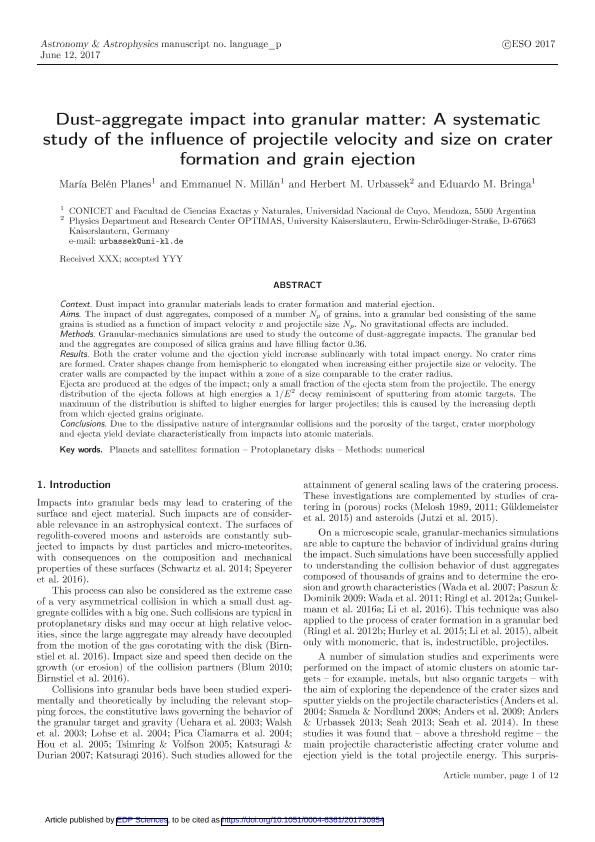Mostrar el registro sencillo del ítem
dc.contributor.author
Planes, María Belén

dc.contributor.author
Millán, Emmanuel Nicolás

dc.contributor.author
Urbassek, Herbert M.

dc.contributor.author
Bringa, Eduardo Marcial

dc.date.available
2018-09-14T18:00:28Z
dc.date.issued
2017-11
dc.identifier.citation
Planes, María Belén; Millán, Emmanuel Nicolás; Urbassek, Herbert M.; Bringa, Eduardo Marcial; Dust-aggregate impact into granular matter: A systematic study of the influence of projectile velocity and size on crater formation and grain ejection; EDP Sciences; Astronomy and Astrophysics; 607; 11-2017; 1-12
dc.identifier.issn
0004-6361
dc.identifier.uri
http://hdl.handle.net/11336/59718
dc.description.abstract
Context. Dust impact into granular materials leads to crater formation and material ejection. Aims. The impact of dust aggregates, composed of a number Np of grains, into a granular bed consisting of the same grains is studied as a function of impact velocity v and projectile size Np. No gravitational effects are included. Methods. Granular-mechanics simulations are used to study the outcome of dust-aggregate impacts. The granular bed and the aggregates are composed of silica grains and have filling factor 0.36. Results. Both the crater volume and the ejection yield increase sublinearly with total impact energy. No crater rims are formed. Crater shapes change from hemispheric to elongated when increasing either projectile size or velocity. The crater walls are compacted by the impact within a zone of a size comparable to the crater radius. Ejecta are produced at the edges of the impact; only a small fraction of the ejecta stem from the projectile. The energy distribution of the ejecta follows at high energies a 1/E2 decay reminiscent of sputtering from atomic targets. The maximum of the distribution is shifted to higher energies for larger projectiles; this is caused by the increasing depth from which ejected grains originate. Conclusions. Due to the dissipative nature of intergranular collisions and the porosity of the target, crater morphology and ejecta yield deviate characteristically from impacts into atomic materials.
dc.format
application/pdf
dc.language.iso
eng
dc.publisher
EDP Sciences

dc.rights
info:eu-repo/semantics/openAccess
dc.rights.uri
https://creativecommons.org/licenses/by-nc-sa/2.5/ar/
dc.subject
Methods: Numerical
dc.subject
Planets And Satellites: Formation
dc.subject
Protoplanetary Disks
dc.subject.classification
Astronomía

dc.subject.classification
Ciencias Físicas

dc.subject.classification
CIENCIAS NATURALES Y EXACTAS

dc.title
Dust-aggregate impact into granular matter: A systematic study of the influence of projectile velocity and size on crater formation and grain ejection
dc.type
info:eu-repo/semantics/article
dc.type
info:ar-repo/semantics/artículo
dc.type
info:eu-repo/semantics/publishedVersion
dc.date.updated
2018-09-12T17:31:54Z
dc.journal.volume
607
dc.journal.pagination
1-12
dc.journal.pais
Francia

dc.journal.ciudad
Paris
dc.description.fil
Fil: Planes, María Belén. Consejo Nacional de Investigaciones Científicas y Técnicas; Argentina. Universidad Nacional de Cuyo. Facultad de Ciencias Exactas y Naturales; Argentina
dc.description.fil
Fil: Millán, Emmanuel Nicolás. Consejo Nacional de Investigaciones Científicas y Técnicas; Argentina. Universidad Nacional de Cuyo. Facultad de Ciencias Exactas y Naturales; Argentina
dc.description.fil
Fil: Urbassek, Herbert M.. University Kaiserslautern; Alemania
dc.description.fil
Fil: Bringa, Eduardo Marcial. Consejo Nacional de Investigaciones Científicas y Técnicas; Argentina. Universidad Nacional de Cuyo. Facultad de Ciencias Exactas y Naturales; Argentina
dc.journal.title
Astronomy and Astrophysics

dc.relation.alternativeid
info:eu-repo/semantics/altIdentifier/doi/https://dx.doi.org/10.1051/0004-6361/201730954
dc.relation.alternativeid
info:eu-repo/semantics/altIdentifier/url/https://www.aanda.org/articles/aa/abs/2017/11/aa30954-17/aa30954-17.html
Archivos asociados
